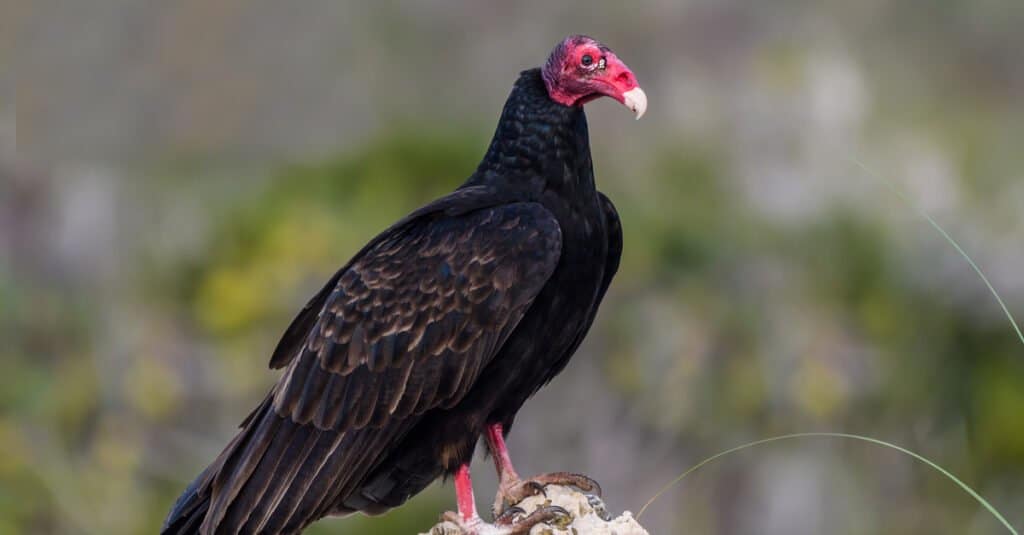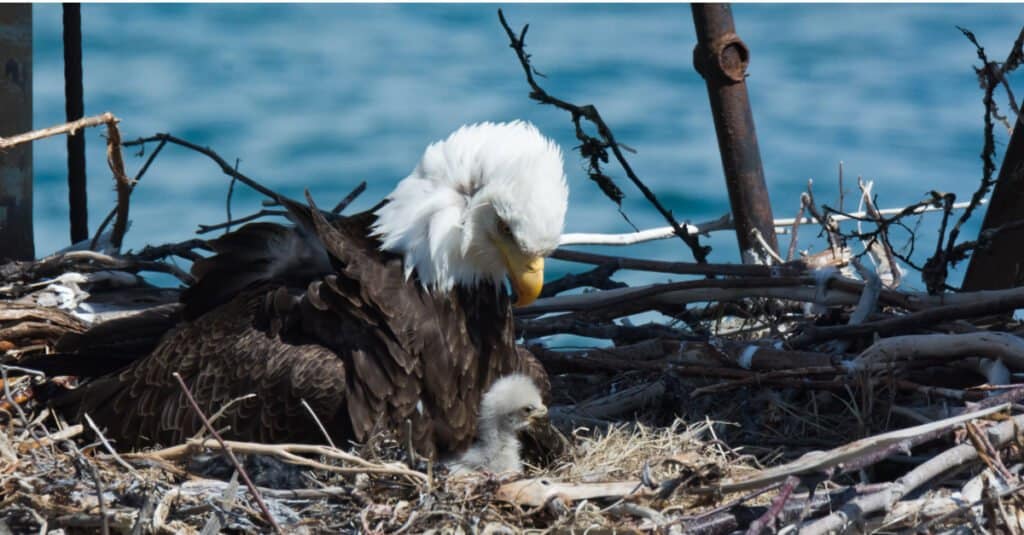Vultures and eagles are raptors that hunt and feed on prey that is large relative to their body sizes. There are many distinct species of each, so in this article, we’ll focus on two that inhabit the same general range, the turkey vulture and the bald eagle.
The turkey vulture receives the ‘turkey’ part of its common name from its resemblance to the wild turkey, with its bald, red head and dark plumage. ‘Vulture’ comes from the Latin vellere, which means to pluck or tear. The bald eagle receives its name from the old English word “balde,” which means white, referring to its white-feathered head. ‘Eagle’ is a word that refers to raptors who hunt sizable prey.
These arch-beaked avians have names that demonstrate some differences between them. Let’s explore the distinctions in-depth of vulture vs eagle.
Comparing a Vulture and an Eagle

| Turkey Vulture | Bald Eagle | |
| Scientific Name | Cathartes aura | Haliaeetus leucocephalus |
| Size | 1.8-5.3 lbs 24-32 inches long 63-72 inches wingspan | 6.6-14 lbs 28-38 inches long 70-90 inches wingspan. |
| Habitat | open country, woods, foothills, subtropical forests, shrublands, pastures, and deserts | wetland habitats: along lakes, coastlines, reservoirs, rivers |
| Diet | Carrion | Fresh prey & carrion |
| Appearance | V-shaped flight, bald red head, weak feet, blunt talons | Flat-plane flight, white-feathered head, strong feet, sharp talons |
| Behavior | Communal | Solitary |
| Call | Hisses or grunts | High-pitched whistling or piping call |
The 6 Key Differences Between a Vulture and an Eagle
The key differences between a vulture and an eagle are their size, habitat, diet, appearance, behavior, and call.
Both vultures and eagles are large birds of prey common throughout North America and differ in many ways. Let’s take a deeper look at their main differences below.
Vulture vs Eagle: Classification
Vultures and Eagles share the same order Accipitriformes, which includes most birds of prey active in the daylight hours. Hawks, eagles, vultures, and kites are all included, where only falcons are left to a separate order.
Old world vultures are closely related to eagles, hawks, kites, and harries, in the family Accipitridae. The New World vultures are part of the Cathartidae family. The most widespread of the New World vultures, and the focus of this article, is the turkey vulture (Cathartes aura). The genus name for the turkey vulture, Cathartes, comes from a Greek word for “purifier,” referring to its role as a cleanser in the ecosystem of cleaning up decomposing corpses.
In this article about vulture vs eagle, we’ll narrow our focus to a specific member of the Accipitridae family, the bald eagle (Haliaeetus leucocephalus). The genus name Haliaeetus comes from a word for ‘sea eagles,’ and leucocephalus is a name derived from the words ‘white’ and ‘head.’ The bald eagle is a sea eagle easily identified by its distinctive white head.
Vulture vs Eagle: Habitat and Range

Bald eagles are found near water, while turkey vultures prefer the open country.
©FloridaStock/Shutterstock.com
Turkey vultures live year-round in the southern United States. The northern United States and southern Canada birds migrate long distances south, down through South America. They migrate in flocks and may fly long distances during migration without feeding. Turkey vultures can be found in open country areas, woods, foothills, subtropical forests, shrublands, pastures, and deserts. They are most common over open country areas and are found near rocky or wooded areas that they can use for nesting sites. They tend to avoid densely forested areas.
The range of bald eagles extends from Canada through the United States and down to northern Mexico. Northern populations migrate south for the winter, while southern populations remain year-round. Bald eagles are common in Alaska, and the majority of their population in the southern states is found in Florida. They can be found in almost any kind of American wetland habitat. Bald eagles also love large lakes and can be seen soaring above lakes and around nearby trees during the summer months. They prefer lakes and reservoirs with abundant fish and access to surrounding forests. They can be found around unfrozen lakes and along coastlines, reservoirs, and rivers in the winter.
Vulture vs Eagle: Diet
Turkey vultures are primarily scavenging carnivores. They eat the flesh of dead and decaying animals almost exclusively, preferring carcasses that are recently deceased. These birds hardly ever kill the animals themselves but instead take advantage of other predators’ prowess. They locate carrion by its decaying odor over a long distance and circle above it before feeding. Their unique sense of smell is uncommon in the bird world.
Dead animals give off Ethyl mercaptan gas produced in the decay process, the same sulfurous compound added to natural gas so that leaks can be detected. Turkey vultures pick up this scent by flying low to the ground. They generally consume the animals before they reach the state of rotting. Turkey vultures play an important part in the ecosystem, disposing of decaying matter before spreading diseases. Less often, they will eat plant matter, live insects, and fish. Turkey vultures eat in an organized manner called “queuing” at a carcass, in which they each wait their turn for a chance to feast.
Bald eagles’ favorite prey is fish. Salmon, herring, shad, and catfish are some of their favorites. However, they are opportunistic predators who will eat anything they can catch, such as waterfowl, other small birds, and various small mammals. Although hunting is one feeding method, they will also scavenge and feed on carrion. This method of feeding is particularly common in juvenile bald eagles. They may even steal food from other birds like osprey when the opportunity presents itself. They catch their fish by swooping down to the water and snatching them up with large and powerful talons. In addition to these sharp talons, the bottom of their feet is lined with spicules, spiny projections that help them have a firm grasp of their prey. Bald eagles may sometimes gorge and spend other periods fasting, depending on food availability.
Vulture vs Eagle: Appearance

Turkey vultures’ heads are bald and red, while bald eagles’ are white and feathered.
©FotoRequest/Shutterstock.com
Turkey vultures are large, darkly colored birds with broad wings. They have distinctive featherless, red heads and a pale bill. They can’t easily kill prey or tear at a carcass with more than their sharp, curved beak. This is due to having very weak feet and blunt talons. On average, they are 1.8-5.3 pounds, 24-32 inches in length, and have a 63-72 inch wingspan. When soaring, they hold their wings slightly raised, appearing as a “V” when seen head-on.
Bald eagles are among the largest birds in North America. Their impressive soaring wingspan can sometimes reach 7 feet across. Most of their body is covered in dark brown plumage, aside from the head and tail feathers which are white. They possess strong, yellow talons and sharp, curved beaks, adapted for catching and killing prey. They are incredibly large birds that weigh 6.6-14 pounds on average, 28-38 inches in length, with a 70-90 inch wingspan. Bald eagles soar with their broad wings on a flat plane.
Vulture vs Eagle: Communication & Calls
Turkey vultures are generally silent creatures, but they’ll hiss or grunt when they feel threatened. They’re pretty timid birds who will regurgitate their meal for another to consume if threatened at a carcass by a fellow scavenger. This is actually the way they respond to most threats – by vomiting. Their vomit is generally an acidic slurry of flesh from dead animals, so vomiting at the source of their threat usually works to prevent further aggression.
As a powerful predator, the bald eagle has a surprisingly muted call. Due to Hollywood’s longtime portrayal, many have come to associate a loud screeching scream with the bald eagle. They primarily use the call of the red-tailed hawk for bald eagle scenes. The bald eagle’s call is a series of high-pitched whistling or piping notes. The female may repeat a soft high-pitched note to signal her readiness for copulation. Bald eagles are generally shy birds who try to avoid conflict, but they will fight when necessary with their sharp talons and beaks. As apex predators, bald eagles face no natural predators. Humans are the main threat to this species.
Vulture vs Eagle: Courtship Behaviors

Although both birds mate for life, their courtships differ.
©Jon C. Beverly/Shutterstock.com
Turkey vultures mate for life and have a unique method for courtship display in which they gather in a circle on the ground and perform ritual hopping movements around the circle. During this ritual, their wings are spread, followed by long flights by the males.
Bald eagles mate for life, pairing with the same mate each breeding season. They engage in fascinating courtship rituals as they establish their bond. The “cartwheel courtship flight” is a sort of sky dance in which two bald eagles fly high and lock talons. After this, they go into a cartwheel spin as they fall toward the earth, releasing talons at the last minute. This behavior is actually seen beyond breeding partners and used at times as a display of the ritualistic battle. Bald eagles in courtship may also chase one another before locking talons and doing rolls.
Vultures vs Eagles: Social Behaviors
Turkey vultures have a bad reputation for their strange appearance and penchant for death, but they are extremely social birds. They roost in large, communal groups and maintain these locations over time, often for many generations. Small groups of foraging turkey vultures will often perch together on a tree or roof, forming a group called a wake. Large flocks of birds will fly together actively foraging. These swirling flocks resemble heated water boiling in a pan, and are referred to as kettles. Often, turkey vultures nest at locations near the communal roost, but these “nests” typically aren’t constructed forms. They take advantage of suitable sites on the ground like caves, hollow logs, stumps, or dense masses of vegetation where they can push matter aside to lay their clutch of 1-3 eggs. Once they choose these sites, they often use them for a decade or more.
Although monogamous, bald eagles are quite solitary creatures. They spend migrations alone but meet with the same breeding partner year after year. Male and female eagles build their nests together, called aeries. They are built on the tops of trees with sticks and twigs. Some pairs revisit the same nest year after year. These platform nests can be up to 6 feet by 6 feet and weigh over a ton. They normally lay a clutch of 2-3 eggs. Bald eagles sometimes meet in large communal roosts and feeding sites, especially in the winter. These are often loud and active, with birds vying for position and competing over prey. When feeding on carrion, bald eagles often push turkey vultures out of their way to feed on the carcass.
The photo featured at the top of this post is © Attis, Public domain, via Wikimedia Commons – License / Original
Thank you for reading! Have some feedback for us? Contact the AZ Animals editorial team.






